A well-maintained yard requires time, effort, and often multiple tools. But what if one machine could do the work of many? That’s where riding lawn mower attachments come in.
These add-ons transform your mower from a simple grass-cutting machine into a versatile, all-season outdoor powerhouse.
Instead of investing in multiple expensive pieces of equipment, you can expand the capabilities of your mower with attachments that help you mow, mulch, aerate, haul, dethatch, plow snow, and even fertilize.
Whether you have a sprawling backyard, a large rural property, or a small homestead, the right accessories can save you hours of work while keeping your landscape in top shape.
In this article, we’ll cover the top versatile riding lawn mower attachments, why they matter, and how they can help you get the most from your machine.
🌱 1. Mulching Kits – Eco-Friendly Lawn Care Done Right
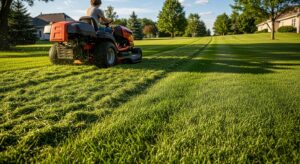
Mulching is one of the easiest ways to naturally nourish your lawn. A mulching kit replaces the standard mower blades with specially designed ones that chop grass clippings into ultra-fine pieces.
These clippings are then redistributed across your lawn, where they break down and return essential nutrients to the soil.
Why It’s Essential:
-
Eliminates the hassle of bagging and dumping clippings.
-
Reduces the need for chemical fertilizers.
-
Helps the soil retain moisture during hot summer days.
-
Keeps lawns greener and healthier with less effort.
💡 Pro Tip: Install a mulching kit early in the season so your lawn benefits from nutrients all year long.
🍂 2. Lawn Sweepers – Say Goodbye to Yard Clutter
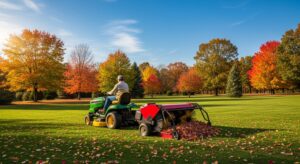
Raking leaves and cleaning up clippings by hand can take hours. A lawn sweeper attachment makes cleanup quick and effortless.
It works like a giant outdoor vacuum, pulling leaves, pine needles, acorns, and grass clippings into a hopper.
Advantages:
-
Saves your back from hours of raking.
-
Keeps your yard neat in a fraction of the time.
-
Great for autumn leaf cleanup.
💡 Pro Tip: Pair your lawn sweeper with a mulching kit for the ultimate combo—nutrients for your soil and a debris-free lawn.
🛒 3. Dump Carts & Utility Trailers – Your Backyard Workhorse
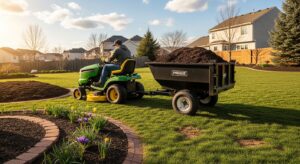
One of the most versatile add-ons is a dump cart or utility trailer. These attachments turn your riding mower into a hauling machine capable of transporting heavy loads of soil, mulch, compost, stones, or even firewood.
Why You Need It:
-
Saves multiple trips with wheelbarrows.
-
Helps with DIY projects like raised garden beds, patios, or landscaping.
-
Comes in steel or poly builds for light and heavy-duty tasks.
💡 Pro Tip: Choose a cart with a tipping or dump feature—it makes unloading soil, gravel, or mulch much easier.
❄️ 4. Snow Blower & Snow Blade Attachments – Four-Season Versatility
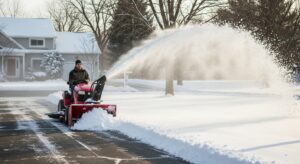
Riding lawn mowers don’t need to hibernate in the winter. With the right snow blower or snow blade, your mower becomes a snow-clearing powerhouse.
-
Snow Blower Attachment: Uses a powerful auger to lift and throw snow, clearing wide paths quickly. Perfect for heavy or frequent snowfalls.
-
Snow Blade/Plow: Pushes snow to the side and is better suited for lighter accumulations.
Benefits:
-
Saves hours of shoveling.
-
Keeps driveways and sidewalks clear.
-
Makes your mower useful year-round.
💡 Pro Tip: Always use tire chains or weights with snow attachments for added traction.
🌾 5. Aerator Attachments – Breathe Life Into Your Lawn
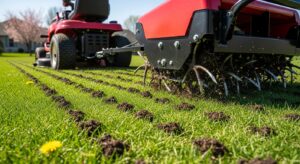
Soil compaction is one of the leading causes of unhealthy lawns. An aerator attachment solves this by poking holes in the ground, allowing air, water, and nutrients to reach the grass roots more effectively.
Key Benefits:
-
Relieves soil compaction.
-
Promotes deeper root growth.
-
Improves fertilizer and water absorption.
💡 Pro Tip: Aerate in early fall or spring for the best results, and follow up with overseeding for a lush, full lawn.
🌿 6. Dethatchers & Lawn Rakes – Reviving Struggling Lawns

Thatch buildup (dead roots, stems, and clippings) suffocates grass and prevents water penetration. A dethatcher or lawn rake attachment pulls up this layer, allowing your lawn to breathe again.
Why It Matters:
-
Prevents fungal diseases and pests.
-
Restores soil circulation.
-
Gives your lawn a clean, refreshed look.
💡 Pro Tip: Combine dethatching with lawn aeration for a complete lawn renewal process.
🌻 7. Lawn Rollers – Smooth and Professional Results
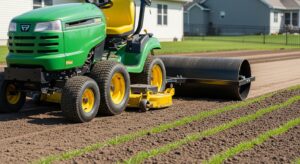
Uneven ground can ruin the look of your yard and make mowing difficult. A lawn roller smooths bumps and ensures even seed-to-soil contact when planting.
Benefits:
-
Flattens small ruts caused by frost or animals.
-
Helps grass seed germinate evenly.
-
Provides that “freshly finished” professional lawn look.
💡 Pro Tip: Avoid overusing rollers, as compacted soil can harm grass growth.
🚜 8. Front-End Loaders – A Mini Tractor for Big Jobs
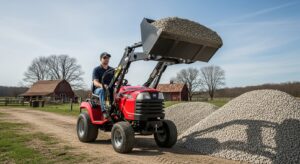
For those with large properties or hobby farms, a front-end loader attachment transforms your riding mower into a small-scale tractor.
Capabilities:
-
Scoops gravel, mulch, and soil.
-
Assists in building projects like pathways or garden beds.
-
It can even help clear snow or animal pens.
💡 Pro Tip: These attachments require heavy-duty mowers and aren’t for smaller residential models. Always check compatibility.
💧 9. Sprayer Attachments – Precision Lawn Care
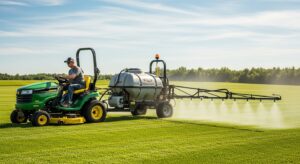
A tow-behind sprayer ensures even application of fertilizers, herbicides, or pesticides across your lawn.
Advantages:
-
Saves time compared to handheld spraying.
-
Provides consistent coverage.
-
Useful for both small and large properties.
💡 Pro Tip: Clean your sprayer thoroughly after each use to prevent clogging and chemical buildup.
🌸 10. Spiker/Seeder Combos – One Step, Two Jobs
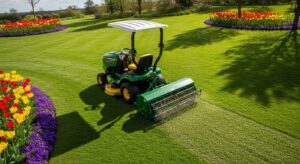
A spiker/seeder combo aerates the soil while planting new seed, ensuring it penetrates deeply for better germination.
Benefits:
-
Saves time by combining tasks.
-
Guarantees healthier, thicker grass growth.
-
Improves results compared to traditional overseeding.
💡 Pro Tip: Use this attachment in the fall for best results, when temperatures are cooler and rain is more frequent.
⚙️ Choosing the Right Attachments for Your Mower
Not every attachment fits every mower. Before purchasing, always check:
-
Compatibility – Is your mower designed for tow-behind or front-mounted attachments?
-
Hitch Style – Does your mower have a sleeve hitch, 3-point hitch, or universal hitch?
-
Yard Size – A larger property may justify more heavy-duty options.
-
Budget – Start with essentials like mulching kits or dump carts, then expand over time.
-
Seasonal Needs – Invest in snow removal tools if you live in a cold climate, or aerators if your lawn struggles with compaction.
🌟 Final Thoughts
Your riding lawn mower doesn’t have to be just a grass-cutting machine. With the right attachments, it becomes a multi-purpose outdoor tool that saves time, money, and effort all year long
. From mulching in the summer to plowing snow in the winter, these add-ons make lawn care easier, faster, and far more effective.
Instead of buying multiple pieces of expensive equipment, think of your mower as the core of your landscaping toolkit. By adding just a few attachments, you can handle everything from soil care to snow clearing, all without breaking a sweat.
So next time you look at your riding mower, don’t just see a machine for mowing grass. See it as a year-round partner for maintaining your outdoor space with versatility, power, and style.
✅ 10 FAQs About Riding Lawn Mower Attachments
1. Can I use any attachment on my riding lawn mower?
Not all attachments are universal. Some fit only specific brands or mower sizes. Always check your mower’s manual or the attachment’s compatibility chart before purchasing.
2. What’s the difference between a mulching kit and a bagger?
A mulching kit chops clippings finely and returns them to the soil as natural fertilizer. A bagger collects grass and leaves for disposal. Both have benefits depending on your lawn goals.
3. Do I need special tires for snow removal attachments?
Yes. Snow blower and snow blade attachments work best with tire chains or wheel weights to prevent slipping and ensure traction on icy surfaces.
4. How often should I aerate my lawn with an attachment?
Most lawns benefit from aeration once or twice per year, typically in spring and fall, depending on soil compaction and grass type.
5. Is a dump cart worth the investment?
Absolutely. A dump cart saves hours of manual labor and makes hauling soil, firewood, or mulch easy. It’s one of the most versatile attachments for any property owner.
6. Will using a dethatcher damage my lawn?
If used correctly, no. Dethatching should only be done when your lawn is actively growing (spring or fall). Overuse can stress grass, so stick to once a year or as needed.
7. Can riding mowers really handle front-end loaders?
Yes, but only heavy-duty garden tractors support them. Standard riding mowers or zero-turn mowers usually don’t have the frame strength for a front-end loader.
8. Are sprayer attachments safe for all chemicals?
Most sprayers are designed for fertilizers, herbicides, and pesticides. However, always read the chemical label to ensure it’s safe for mechanical sprayers.
9. How do I maintain my mower attachments?
Clean after each use, lubricate moving parts, and store in a dry place. Seasonal attachments like snow blowers should be serviced before storage to prevent rust.
10. What’s the best attachment for a beginner?
If you’re just starting, a mulching kit, dump cart, or lawn sweeper is the most practical investment. They’re affordable, easy to install, and give immediate benefits.